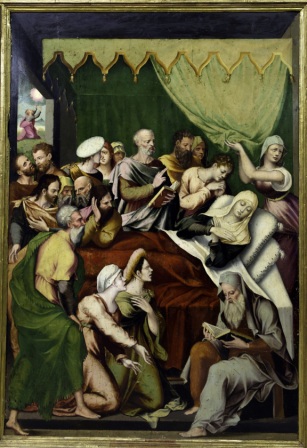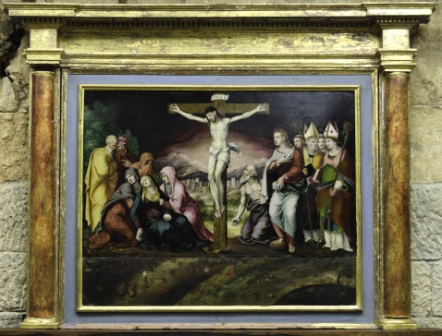18 August 2014
Lectures
THE MONASTERY OF TULEBRAS
Around the main altarpiece of Tulebras: a jewel of the Renaissance in Navarre
Mr. Jesús Criado Mainar
University of Zaragoza
The main altarpiece of the monastery of Nuestra Señora de la Caridad de Tu-lebras is one of the most notable creations of Navarrese painting from the third quarter of the 16th century. It should be related to the activity of the Saragossa workshops and is the result of the relations that this monastery maintained with the Aragonese Cistercian Order and, specifically, with its most important representative, Friar Hernando de Aragón, a member of the Aragonese Royal Household who, after joining the Order of Saint Bernard, served as abbot of Nuestra Señora de Veruela (1535-1539) and later archbishop of Saragossa (1539-1575). Fray Lope framework, his secretary, succeeded him as abbot of Veruela (1539-1560), a position which entailed the responsibility of acting as visitator of the Order in Tulebras; of the four coats of arms included in the predella, only that of Fray Lope can be identified.
The altarpiece was dismantled in the 1980s and is preserved in the monastery museum. Old photographs confirm that before it was dismantled it had already lost part of the original masonry and with it other possible heraldic elements that would help to fit the circumstances of its creation, no doubt in relation to the alterations made to the church in the mid-16th century that led to the reconstruction of its roof by the abbesses María de Beaumont y Navarra (1547-1559) and Ana Pasquier de Eguarás (1559-1573). Archbishop Aragón supported the work with alms that enabled the new vault to be completed in 1565.
We do not have data about the realisation of this great pictorial business , but it is most likely that it was commissioned during the government of Ana Pasquier de Eguarás and after 1565; the date of the death of Fray Hernando de Aragón (†1575) provides a reasonable deadline for its completion. Professor José Rogelio Buendía was the first to concede its authorship to the Zaragozan painter Jerónimo Vallejo alias Cósida (doc. 1527-1591, †1592) and since then all specialists have accepted his intuition. Cósida maintained a very close relationship with Archbishop Aragón and worked for him from the time he was Abbot of Veruela. Thus, among many other projects, in 1550 Fray Hernando entrusted her with the design and coordination of the work on his funerary chapel of San Bernardo de la Seo in Zaragoza. But what interests us now is that he also provided him with commissions linked to the Cistercian Order, such as the execution of the titular altarpieces of the women's monasteries of Cambrón (1562) and Trasobares (1566).
Photographs taken prior to the dismantling of our altarpiece confirm that most of its components still survive. The whole rested on a bench articulated around a tabernacle, or rather a painting, and its side compartments contained panels of the Santos Juanes (Saints John and John the Baptist). The noble area consisted of three houses with a Dormition of the Virgin between Saint Mary Magdalene and Saint Nicholas of Bari; the side panels were topped by clipeos depicting King Saint Louis of France and Prince Saint Hermenegild. In the attic there is a Calvary with a rather complex composition, the lower third of which plays badly with the upper part and seems at first glance to be an addition. It is likely that the whole was originally crowned by a semicircular panel with a trifacial Trinity in a similar style to the other pieces, although when the altarpiece was dismantled it was no longer part of the ensemble; according to Carmen Morte, it may have been removed around 1628, when Pope Urban VIII prohibited the public display of this iconography.
In this programme it is striking that the central panel is dedicated to the Transitus of the Virgin, when the monastery is dedicated to Our Lady of Charity. It should be remembered, however, that in 1623 a lay brotherhood was founded in Tulebras in honour of this Marian cult and that ten years later, in 1633, the abbess Beatriz Español promoted the Building of a chapel to house the image of the Virgin of La Cama, which has come down to us much modified; what we do not know is whether this brotherhood was established after the altarpiece was completed or whether it reflects an older tradition. We also find it peculiar that the polyptych dedicates the lateral recesses of the noble area to Saint Mary Magdalene and Saint Nicholas of Bari, in a location where we would have expected to find personalities of the Cistercian Order or Saint Bernard, founder of the Cistercian Order, collegiate with Saint Benedict.

Transitus of the Virgin
Altarpiece of the Cistercian monastery of Tulebras
The presence of King Saint Louis IX of France and the Visigothic prince Saint Hermenegild, for whom the archbishop of Aragon had a very particular interest -we do not know if devotion- that led him to depict them in the altarpiece of the chapel of Saint Benedict in the Seo de Zaragoza, erected as a mausoleum for his relatives and servants, and also painted by Cosida, cannot go unnoticed. His faithful secretary Friar Lope framework also incorporated them into the altarpiece of his funerary chapel of San Bernardo de Veruela, now in the parish church of Vera de Moncayo, in whose noble area we find in large format the Death of Saint Louis of France and the Beheading of Saint Hermenegild.
With regard to the latter, it is worth remembering that Friar Hernando de Aragón was the natural son of Archbishop Alonso de Aragón, who in turn was the fruit of an extramarital relationship between King Ferdinand II the Catholic and the noblewoman Ana de Gurrea. Although Don Alonso and Don Hernando always enjoyed a firm position at court, their illegitimate status was crystal clear, so Don Hernando strove to claim his membership of the family and his proximity to the crown by means of this iconographic trickery subject ; In fact, on the sides of the altarpiece of his funeral chapel, two portrait galleries were included in which the "Aragonese" monarchs - Alfonso V the Magnanimous, John II, Ferdinand the Catholic and Charles V - appear in collegiality with the four archbishops of Zaragoza of the Royal House of Aragon - John I, Alonso, John II and Hernando. This fact, together with the inclusion of the heraldry of Friar Lope framework on one of the pilasters of the bench, confirms that the commission for the Tulebras altarpiece was forged in the circle of the prelate's servants.
The rest of the iconographic peculiarities are better understood if we compare this set with what Archbishop Hernando de Aragón ordered to be represented in 1562 in the disappeared main altarpiece of the Cistercian monastery of Cambrón, near the Zaragoza town of Sádaba. The general layout of both polyptychs was identical, with the sole exception of the attic, which in Cambrón only included a semi-circular Trinity. The side houses of the bench were occupied, as in Tulebras, by the Holy Johns, but in the central one there was a panel with the Calvary. The side streets of the body were reserved for Saint Mary Magdalene - as in Tulebras - and for the bishop Saint Babil - at place de San Nicolás de Bari - topped with medallions of Saint Peter and Saint Paul - instead of Saint Louis of France and Saint Hermenegild -. In the main opening there was a large panel with the Assumption of the Virgin and, as mentioned above, a Trinity in the attic as a finial.
It is important to stress that the Calvary of Tulebras, as we see it today, seems to have been recreated in the area leave. In fact, it is possible that when around 1628 it became imperative to remove the Trinitarian panel due to its, to say the least, heterodox character, it was decided to place the panel of the Calvary in its position, for which it would seem advisable to raise it in the part leave and replace the columns flanking it. At the same time, the shafts of the columns of the politician's body would also be renewed and the tabernacle now on display would also be commissioned, no doubt designed to replace the Calvary.

Calvary
Altarpiece of the Cistercian monastery of Tulebras
